Hyundai Elantra 2018 Owner's Manual
Manufacturer: HYUNDAI, Model Year: 2018, Model line: Elantra, Model: Hyundai Elantra 2018Pages: 526, PDF Size: 17.2 MB
Page 501 of 526
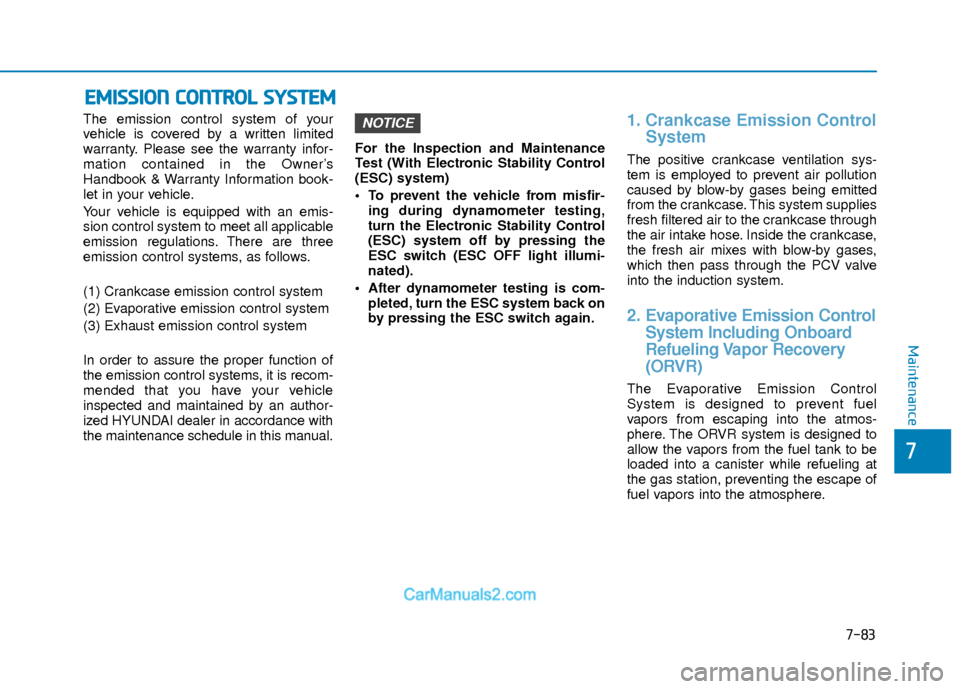
7-83
7
Maintenance
The emission control system of your
vehicle is covered by a written limited
warranty. Please see the warranty infor-
mation contained in the Owner’s
Handbook & Warranty Information book-
let in your vehicle.
Your vehicle is equipped with an emis-
sion control system to meet all applicable
emission regulations. There are three
emission control systems, as follows.
(1) Crankcase emission control system
(2) Evaporative emission control system
(3) Exhaust emission control system
In order to assure the proper function of
the emission control systems, it is recom-
mended that you have your vehicle
inspected and maintained by an author-
ized HYUNDAI dealer in accordance with
the maintenance schedule in this manual.For the Inspection and Maintenance
Test (With Electronic Stability Control
(ESC) system)
To prevent the vehicle from misfir-
ing during dynamometer testing,
turn the Electronic Stability Control
(ESC) system off by pressing the
ESC switch (ESC OFF light illumi-
nated).
After dynamometer testing is com- pleted, turn the ESC system back on
by pressing the ESC switch again.1. Crankcase Emission Control System
The positive crankcase ventilation sys-
tem is employed to prevent air pollution
caused by blow-by gases being emitted
from the crankcase. This system supplies
fresh filtered air to the crankcase through
the air intake hose. Inside the crankcase,
the fresh air mixes with blow-by gases,
which then pass through the PCV valve
into the induction system.
2. Evaporative Emission ControlSystem Including Onboard
Refueling Vapor Recovery
(ORVR)
The Evaporative Emission Control
System is designed to prevent fuel
vapors from escaping into the atmos-
phere. The ORVR system is designed to
allow the vapors from the fuel tank to be
loaded into a canister while refueling at
the gas station, preventing the escape of
fuel vapors into the atmosphere.
NOTICE
E EM
M I
IS
S S
SI
IO
O N
N
C
C O
O N
NT
TR
R O
O L
L
S
S Y
Y S
ST
T E
EM
M
Page 502 of 526
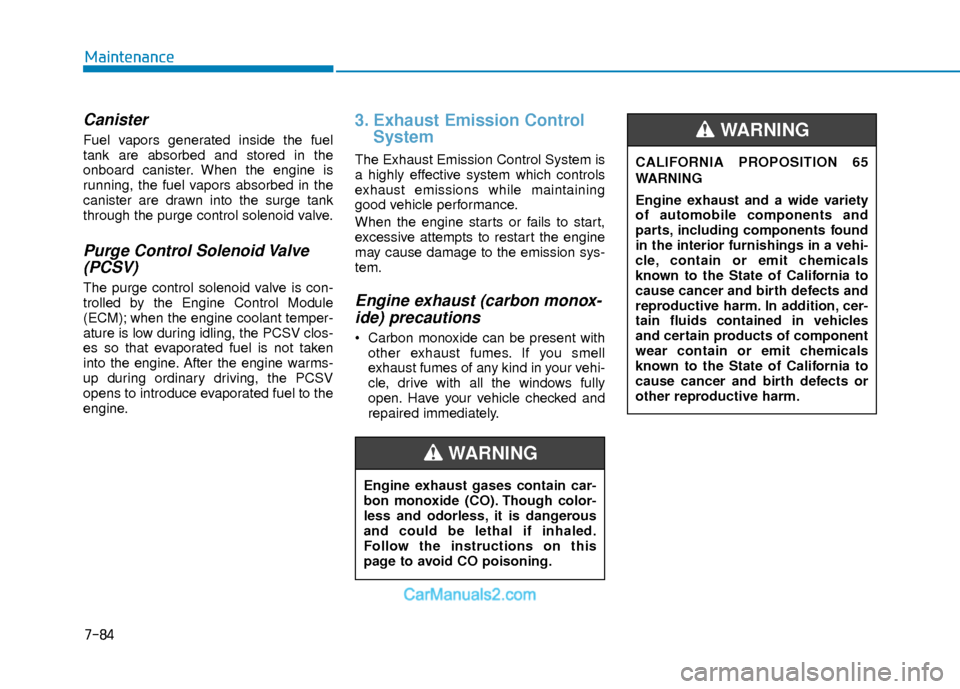
7-84
Maintenance
Canister
Fuel vapors generated inside the fuel
tank are absorbed and stored in the
onboard canister. When the engine is
running, the fuel vapors absorbed in the
canister are drawn into the surge tank
through the purge control solenoid valve.
Purge Control Solenoid Valve(PCSV)
The purge control solenoid valve is con-
trolled by the Engine Control Module
(ECM); when the engine coolant temper-
ature is low during idling, the PCSV clos-
es so that evaporated fuel is not taken
into the engine. After the engine warms-
up during ordinary driving, the PCSV
opens to introduce evaporated fuel to the
engine.
3. Exhaust Emission Control System
The Exhaust Emission Control System is
a highly effective system which controls
exhaust emissions while maintaining
good vehicle performance.
When the engine starts or fails to start,
excessive attempts to restart the engine
may cause damage to the emission sys-
tem.
Engine exhaust (carbon monox-
ide) precautions
Carbon monoxide can be present with
other exhaust fumes. If you smell
exhaust fumes of any kind in your vehi-
cle, drive with all the windows fully
open. Have your vehicle checked and
repaired immediately.
Engine exhaust gases contain car-
bon monoxide (CO). Though color-
less and odorless, it is dangerous
and could be lethal if inhaled.
Follow the instructions on this
page to avoid CO poisoning.
WARNING
CALIFORNIA PROPOSITION 65
WARNING
Engine exhaust and a wide variety
of automobile components and
parts, including components found
in the interior furnishings in a vehi-
cle, contain or emit chemicals
known to the State of California to
cause cancer and birth defects and
reproductive harm. In addition, cer-
tain fluids contained in vehicles
and certain products of component
wear contain or emit chemicals
known to the State of California to
cause cancer and birth defects or
other reproductive harm.
WARNING
Page 503 of 526
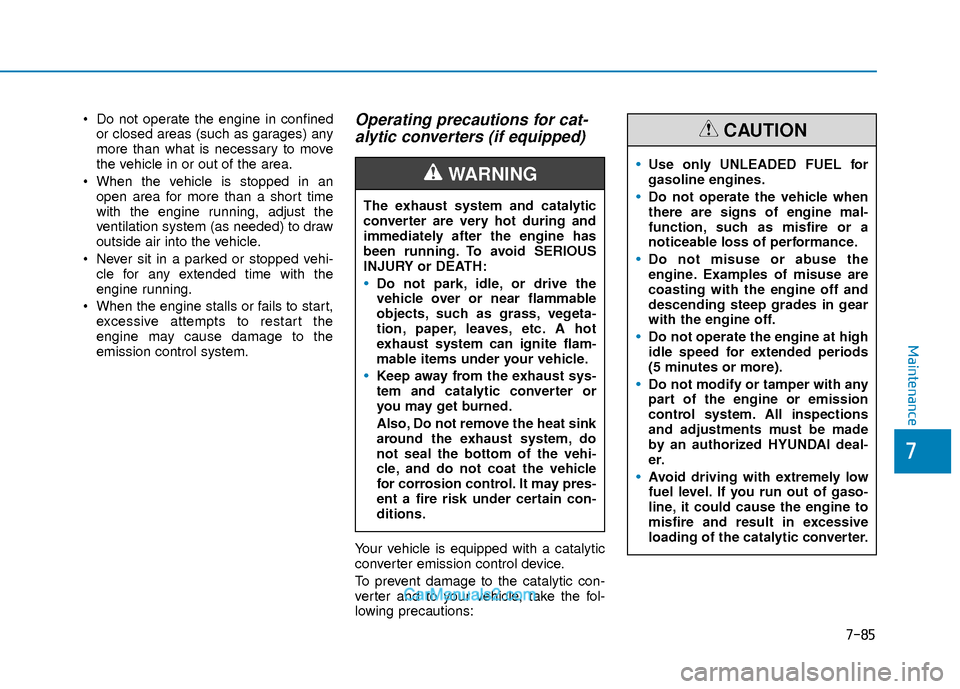
7-85
7
Maintenance
Do not operate the engine in confinedor closed areas (such as garages) any
more than what is necessary to move
the vehicle in or out of the area.
When the vehicle is stopped in an open area for more than a short time
with the engine running, adjust the
ventilation system (as needed) to draw
outside air into the vehicle.
Never sit in a parked or stopped vehi- cle for any extended time with the
engine running.
When the engine stalls or fails to start, excessive attempts to restart the
engine may cause damage to the
emission control system.Operating precautions for cat-alytic converters (if equipped)
Your vehicle is equipped with a catalytic
converter emission control device.
To prevent damage to the catalytic con-
verter and to your vehicle, take the fol-
lowing precautions: The exhaust system and catalytic
converter are very hot during and
immediately after the engine has
been running. To avoid SERIOUS
INJURY or DEATH:
Do not park, idle, or drive the
vehicle over or near flammable
objects, such as grass, vegeta-
tion, paper, leaves, etc. A hot
exhaust system can ignite flam-
mable items under your vehicle.
Keep away from the exhaust sys-
tem and catalytic converter or
you may get burned.
Also, Do not remove the heat sink
around the exhaust system, do
not seal the bottom of the vehi-
cle, and do not coat the vehicle
for corrosion control. It may pres-
ent a fire risk under certain con-
ditions.
WARNING Use only UNLEADED FUEL for
gasoline engines.
Do not operate the vehicle when
there are signs of engine mal-
function, such as misfire or a
noticeable loss of performance.
Do not misuse or abuse the
engine. Examples of misuse are
coasting with the engine off and
descending steep grades in gear
with the engine off.
Do not operate the engine at high
idle speed for extended periods
(5 minutes or more).
Do not modify or tamper with any
part of the engine or emission
control system. All inspections
and adjustments must be made
by an authorized HYUNDAI deal-
er.
Avoid driving with extremely low
fuel level. If you run out of gaso-
line, it could cause the engine to
misfire and result in excessive
loading of the catalytic converter.
CAUTION
Page 504 of 526
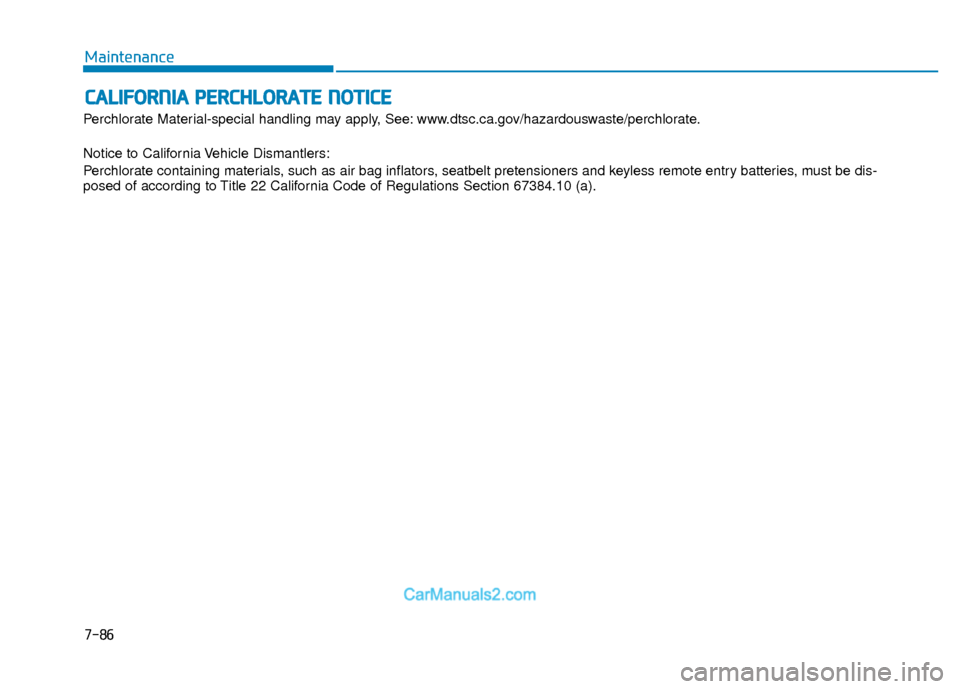
7-86
Maintenance
C
CA
A L
LI
IF
F O
O R
RN
N I
IA
A
P
P E
ER
R C
CH
H L
LO
O R
RA
A T
TE
E
N
N O
O T
TI
IC
C E
E
Perchlorate Material-special handling may apply, See: www.dtsc.ca.gov/hazardouswaste/perchlorate.
Notice to California Vehicle Dismantlers:
Perchlorate containing materials, such as air bag inflators, seatbelt pretensioners and keyless remote entry batteries, must be dis-
posed of according to Title 22 California Code of Regulations Section 67384.10 (a).
Page 505 of 526
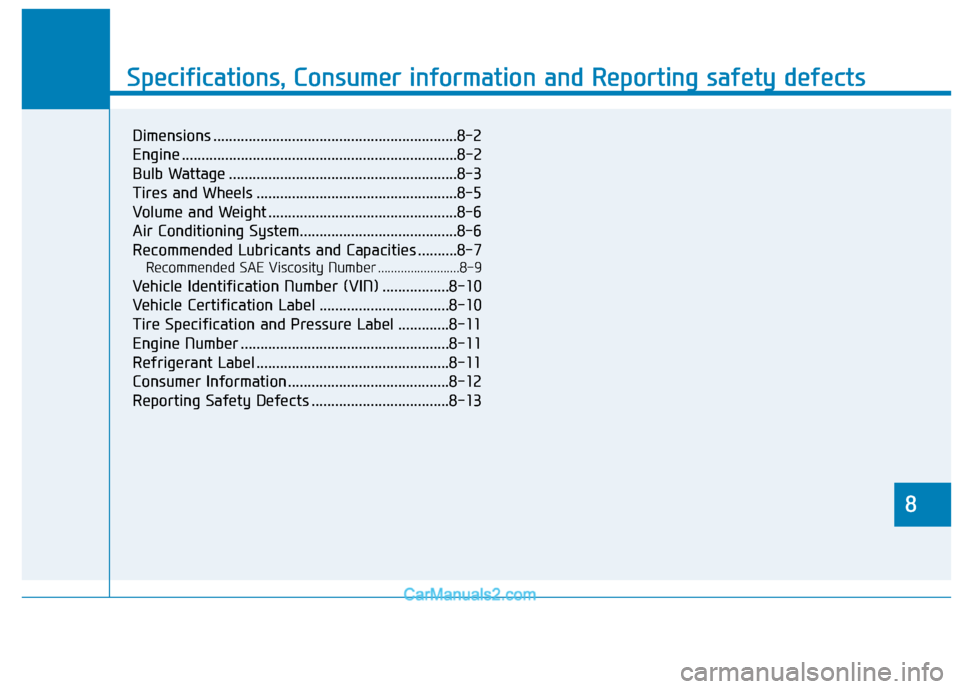
888
Specifications & Consumer information
8
Specifications, Consumer information and Reporting safety defects
8
Dimensions ..............................................................8-2
Engine ......................................................................8-\
2
Bulb Wattage ..........................................................8-3
Tires and Wheels ...................................................8-5
Volume and Weight ................................................8-6
Air Conditioning System........................................8-6
Recommended Lubricants and Capacities ..........8-7
Recommended SAE Viscosity Number .........................8-9
Vehicle Identification Number (VIN) .................8-10
Vehicle Certification Label .................................8-10
Tire Specification and Pressure Label .............8-11
Engine Number .....................................................8-11
Refrigerant Label .................................................8-11
Consumer Information .........................................8-12
Reporting Safety Defects ...................................8-13
Page 506 of 526
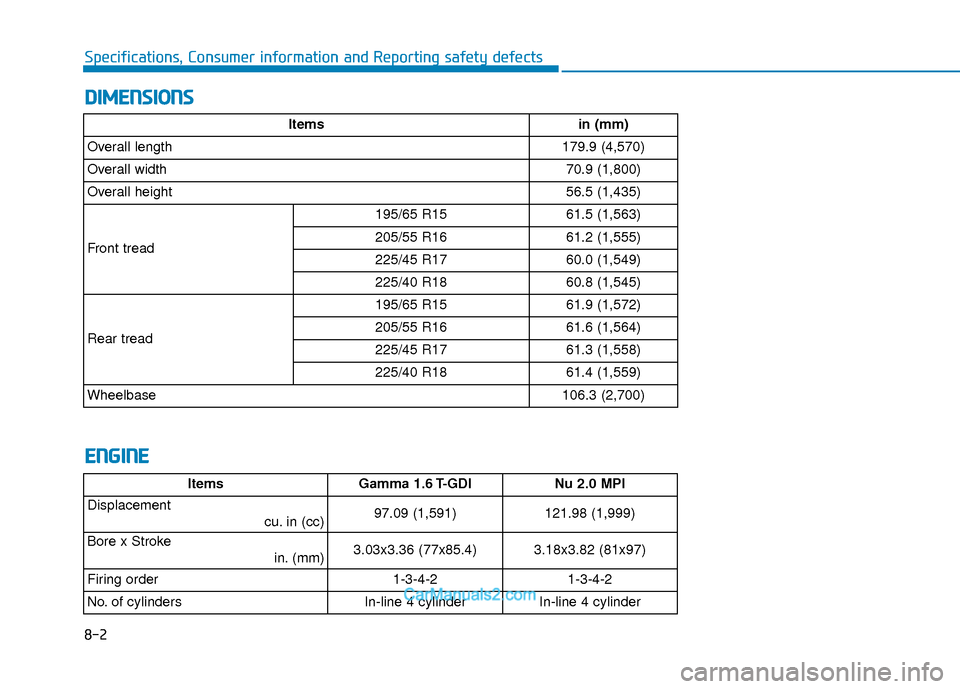
D
DI
IM
M E
EN
N S
SI
IO
O N
NS
S
8-2
Specifications, Consumer information and Reporting safety defects
E
EN
N G
GI
IN
N E
E
Itemsin (mm)
Overall length179.9 (4,570)
Overall width70.9 (1,800)
Overall height56.5 (1,435)
Front tread
195/65 R1561.5 (1,563)
205/55 R1661.2 (1,555)
225/45 R1760.0 (1,549)
225/40 R1860.8 (1,545)
Rear tread
195/65 R1561.9 (1,572)
205/55 R1661.6 (1,564)
225/45 R1761.3 (1,558)
225/40 R1861.4 (1,559)
Wheelbase106.3 (2,700)
Items Gamma 1.6 T-GDINu 2.0 MPI
Displacement
cu. in (cc)97.09 (1,591)121.98 (1,999)
Bore x Stroke in. (mm)3.03x3.36 (77x85.4)3.18x3.82 (81x97)
Firing order1-3-4-21-3-4-2
No. of cylindersIn-line 4 cylinderIn-line 4 cylinder
Page 507 of 526
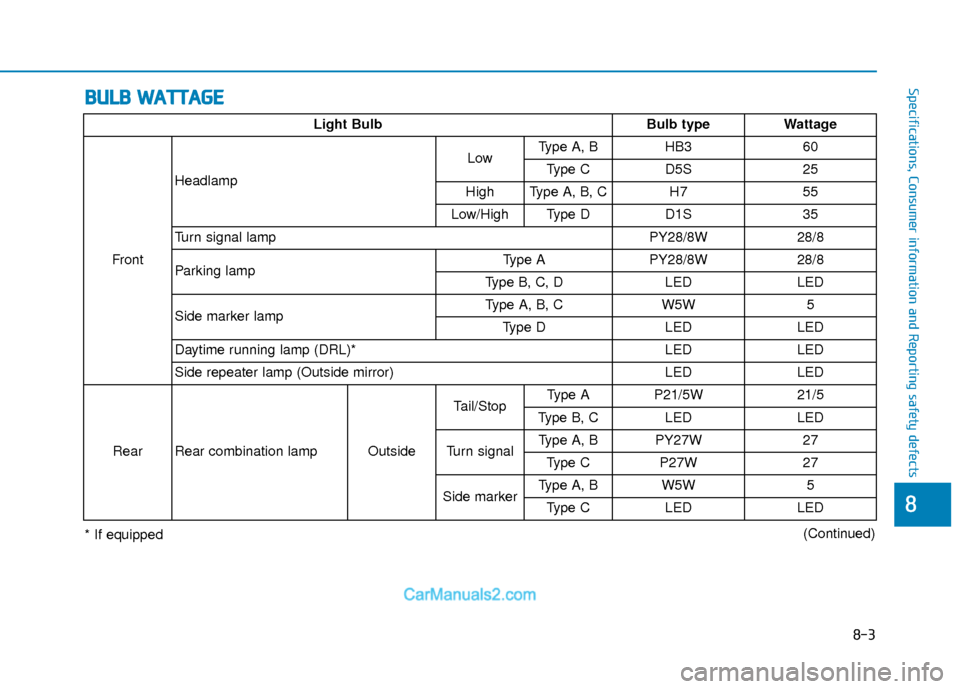
B
BU
U L
LB
B
W
W A
AT
TT
TA
A G
G E
E
8-3
88
Specifications, Consumer information and Reporting safety defects
Light Bulb Bulb typeWattage
Front Headlamp
Low
Type A, B HB3
60
Type C D5S 25
High Type A, B, C H7 55
Low/High Type D D1S35
Turn signal lamp PY28/8W28/8
Parking lamp Type A
PY28/8W 28/8
Type B, C, D LEDLED
Side marker lamp Type A, B, C
W5W5
Type D LEDLED
Daytime running lamp (DRL)* LEDLED
Side repeater lamp (Outside mirror) LEDLED
Rear Rear combination lamp Outside Tail/Stop
Type A P21/5W
21/5
Type B, C LED LED
Turn signal Type A, B PY27W
27
Type C P27W 27
Side marker Type A, B W5W
5
Type C LED LED
(Continued)
* If equipped
Page 508 of 526
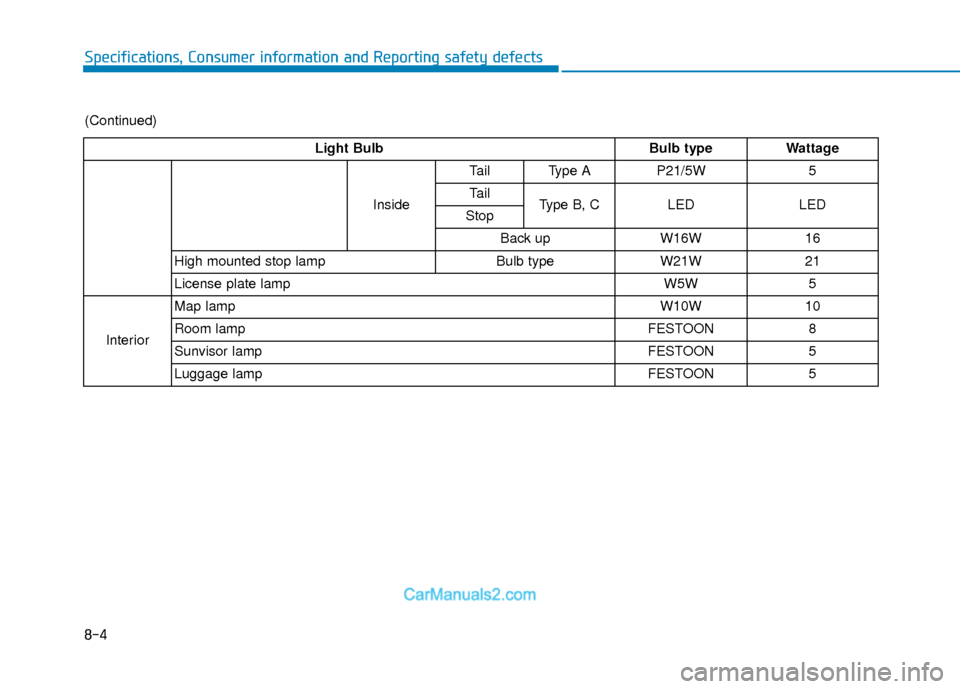
8-4
Specifications, Consumer information and Reporting safety defects
Light BulbBulb typeWattage
Inside Tail Type A P21/5W
5
Tail Type B, C LED LED
Stop
Back up W16W16
High mounted stop lamp Bulb typeW21W21
License plate lamp W5W5
Interior Map lamp
W10W10
Room lamp FESTOON8
Sunvisor lamp FESTOON5
Luggage lamp FESTOON5
(Continued)
Page 509 of 526
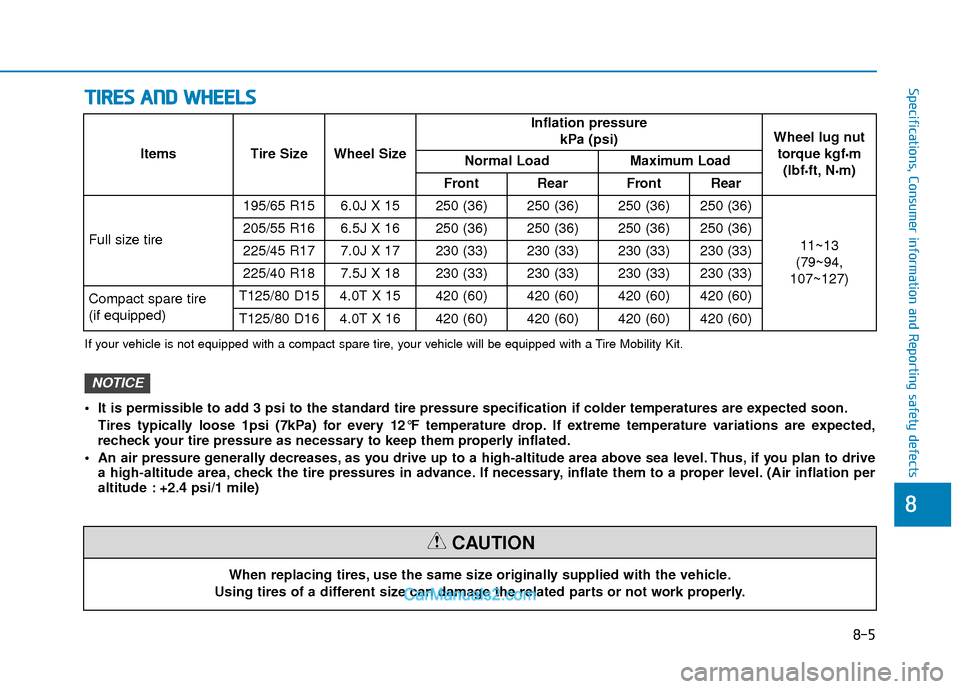
T
TI
IR
R E
ES
S
A
A N
N D
D
W
W H
HE
EE
EL
LS
S
8-5
88
Specifications, Consumer information and Reporting safety defects
When replacing tires, use the same size originally supplied with the vehicle.
Using tires of a different size can damage the related parts or not work properly.
CAUTION
If your vehicle is not equipped with a compact spare tire, your vehicle will be equipped with a Tire Mobility Kit.
Items Tire SizeWheel Size
Inflation pressure kPa (psi)Wheel lug nuttorque kgf
•m
(lbf
ft, Nm)Normal LoadMaximum Load
FrontRearFrontRear
Full size tire
195/65 R156.0J X 15250 (36)250 (36)250 (36)250 (36)
11~13
(79~94,
107~127)
205/55 R166.5J X 16250 (36)250 (36)250 (36)250 (36)
225/45 R177.0J X 17230 (33)230 (33)230 (33)230 (33)
225/40 R187.5J X 18230 (33)230 (33)230 (33)230 (33)
Compact spare tire
(if equipped)T125/80 D154.0T X 15420 (60)420 (60)420 (60)420 (60)
T125/80 D164.0T X 16420 (60)420 (60)420 (60)420 (60)
It is permissible to add 3 psi to the standard tire pressure specification if colder temperatures are expected soon.
Tires typically loose 1psi (7kPa) for every 12°F temperature drop. If extreme temperature variations are expected,
recheck your tire pressure as necessary to keep them properly inflated.
An air pressure generally decreases, as you drive up to a high-altitude area above sea level. Thus, if you plan to drive a high-altitude area, check the tire pressures in advance. If necessary, inflate them to a proper level. (Air inflation per
altitude : +2.4 psi/1 mile)
NOTICE
Page 510 of 526
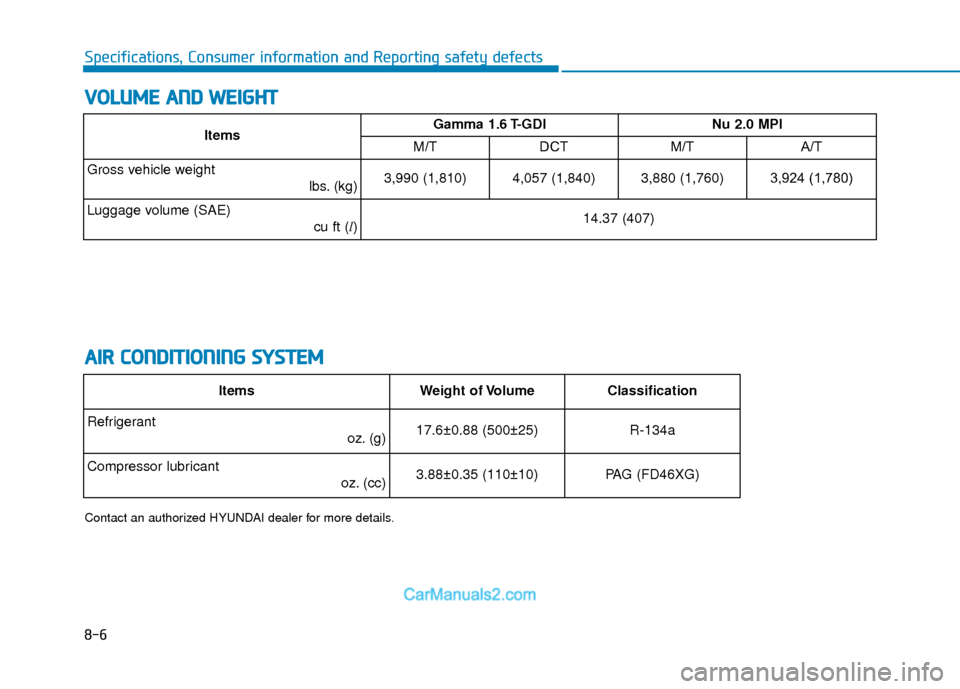
8-6
Specifications, Consumer information and Reporting safety defects
V
VO
O L
LU
U M
M E
E
A
A N
N D
D
W
W E
EI
IG
G H
H T
T
A
A I
IR
R
C
C O
O N
ND
DI
IT
T I
IO
O N
NI
IN
N G
G
S
S Y
Y S
ST
T E
EM
M
Contact an authorized HYUNDAI dealer for more details.
ItemsGamma 1.6 T-GDINu 2.0 MPI
M/TDCTM/TA/T
Gross vehicle weight
lbs. (kg)3,990 (1,810)4,057 (1,840)3,880 (1,760)3,924 (1,780)
Luggage volume (SAE) cu ft (l)14.37 (407)
ItemsWeight of VolumeClassification
Refrigerant oz. (g) 17.6±0.88 (500±25)R-134a
Compressor lubricantoz. (cc) 3.88±0.35 (110±10)PAG (FD46XG)